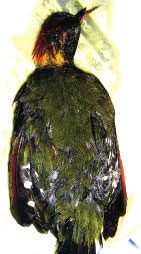Tragic end of a woodpecker
by K.G.H. Munidasa
A pet dog named, “Jackie” in my neighbourhood, recently killed a
woodpecker, brought the dead body home and left it at the doorstep for
his master to see. The master and his family members, who had never seen
such a bird, examined the still warm carcass, scolding the dog all the
time for its ungodly act. After admiring the bird and its colour scheme,
they packed the dead body in a shopping bag and sent it to me for
identification.
The carcass was badly mangled and bathed in blood, with the tongue
sticking fully out of the bill. By the general appearance I could take
it for a woodpecker, and after leafing through the bird literature in my
book cupboard, and perusing the colour pictures in Henry’s “Guide to the
Birds of Ceylon”, I identified the bird as a male of the Ceylon Yellow-naped
Woodpecker.
Later in the day when the owner of the dog met me, I showed him a
colour picture of the woodpecker and he was satisfied.
Plentiful in hill country
The Ceylon Yellow-naped Woodpecker Picus chlorolopus Wellsi,
according to Phillips (Annotated Checklist - 1978 Revised Edition), is
one of the nine forms of woodpeckers found in Sri Lanka, and a race
peculiar to the island. Well distributed, in small numbers, throughout
the forests and woodlands of the wet lowlands and some adjoining areas
of the Dry Zone, it is found to be more plentiful in the Central Hill
Zone to altitudes of about 7,000 feet.
 |
|
Picture of dead
woodpecker |
“This woodpecker inhabits the jungles and well-wooded village gardens
and joins troupes of many species of birds, which daily traverse the
jungle for food. It often descends to the ground more freely than the
other woodpeckers and breaks up rotten logs or cowpats for the insects
they contain. Its food consists of wood-boring insects and their larvae,
termites, especially ants of which it eats large numbers” (Henry-1955).
Description of sexes: In the male the feathers of the forehead,
crown, crest and a strip down the jaws are crimson and the nape yellow
while the upper plumage and wing covers are olive-green. The female
resembles the male except that the foreparts of her head are
greenish-grey and she lacks the crimson moustachel stripe.
In the Kelani Valley I have recorded this woodpecker for the Ceylon
Bird Club over the years from 1992 to 1997, more often singly, and
occasionally in pairs or accompanied by juveniles.
With all my personal experiences with this woodpecker, I am yet to
come by a nest within this area. In January 1992, a pair was calling
incessantly in my home garden for two consecutive days, from morning
until nightfall, and I took for granted that such behaviour was a clear
sign of breeding. But, consequently all my efforts to trace the nesting
place ended in failure.
Nest with young
In February that year the Ceylon Bird Club (CBC) recorded the
discovery of an active nest in a home garden at Walahanduwa in Galle. It
was in the dead stump (7 inches dia.) of a Maditiya adenanthera pavonina
tree about six feet above the ground. The nest housed two young, about
five days old. Both the parents fed the young, but strangely enough, the
feeding took place at long intervals of between 60-90 minutes. In three
weeks the young, which turned out to be a male and a female, started to
peep out of the nest hole when accepting the food the parents offered
them.
In February 1973, that eminent bird photographer Dr. T.S.U. de Zilva,
who had come upon an occupied nest of this woodpecker in Badulla has in
his notes to the CBC suggested, “call note is very accurately described
by Henry, indeed like one of the notes of the Indian Pitta” and added
that “in the vicinity of the nest a different note which sounds like a
feeble cackling of the Common Mynah was noted.”
The following are some of the sightings placed on record by the CBC:
Ella, Kandy (1971), off Kurunegala (1972), Bandarawela (1973), Lunugala
(1974), Pelmadulla (1975), Kitulgala, Welimada, Labugama (1977),
Sinharaja Forest (numerous sightings).
Uva Plateau, (elevation 4,000 ft.) in 1997 in a peculiar behaviour
recorded for the yellow-naped Woodpecker, one was seen chipping
relatively larger holes in perfectly sound Cypress trees, leaving
chisel-like marks in the wood.
The nesting season of this bird falls from February to May. Like most
other woodpeckers the nest is placed in a cavity dug in a tree, either
trunk or branch, and its height varies greatly; 2 feet 9 inches from the
ground has been recorded, but most nests are 10-20 feet up. The clutch
of unmarked white eggs numbers one or two.
|

